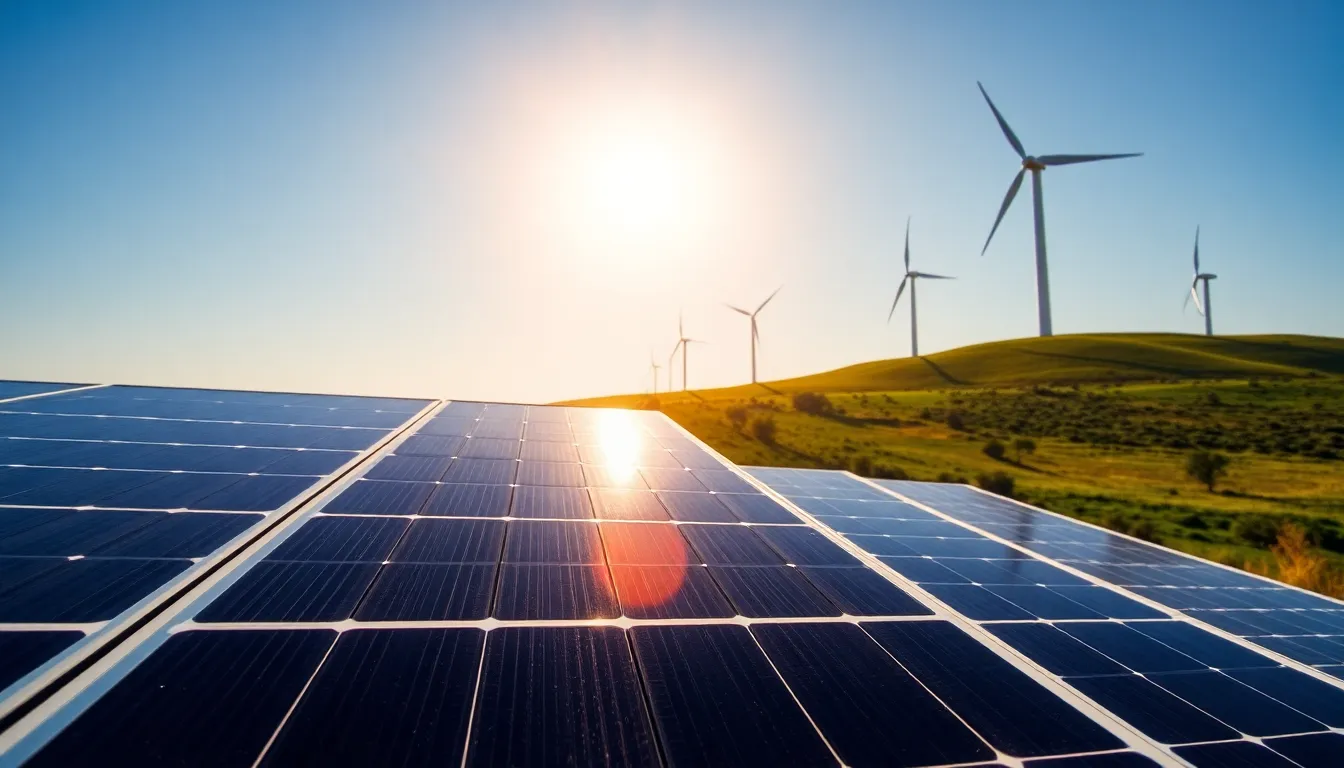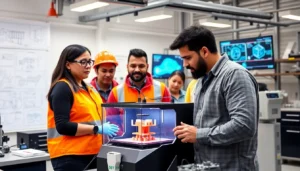Table of Contents
ToggleIn a world where the planet is throwing tantrums and climate change is the new buzzword, green technology applications are like a superhero cape for our ailing Earth. These innovations not only promise to save the environment but also make life easier and more efficient—talk about a win-win! Imagine harnessing the sun’s rays to power your home while sipping organic kale smoothies.
From solar panels that double as chic home decor to electric cars that make you feel like you’re gliding on a cloud, green tech is transforming everyday life. It’s time to embrace these eco-friendly solutions that are as trendy as they are effective. Dive into the fascinating realm of green technology applications and discover how they’re reshaping the future—one sustainable gadget at a time.
Overview of Green Technology Applications
Green technology encompasses a variety of innovative applications that aim to enhance environmental sustainability. These applications significantly lower carbon footprints while improving energy efficiency and resource management.
Solar energy systems capture sunlight to generate electricity or heat. Solar panels convert sunlight into usable energy, making homes and businesses less reliant on fossil fuels. Wind turbines also harness natural energy by converting wind into electricity, contributing to a cleaner energy supply.
Electric vehicles, or EVs, present another prominent green technology application. These vehicles reduce greenhouse gas emissions while offering lower operating costs compared to traditional gasoline-powered cars. Battery technology in EVs continues to evolve, enhancing range and performance.
Energy-efficient appliances promote significant reductions in energy consumption. Devices such as LED lighting, Energy Star-rated refrigerators, and smart thermostats not only save consumers money but also contribute to environmental protection. These appliances function effectively while minimizing waste and conserving resources.
Water purification systems employ advanced technologies to provide clean drinking water. Rainwater harvesting systems capture and store rain for irrigation and domestic use, further promoting sustainable water management.
Biomass energy and biofuels transform organic materials into renewable energy sources. This approach decreases reliance on fossil fuels while utilizing waste products, thereby addressing environmental concerns related to waste disposal.
Green building practices focus on sustainable construction methods. These practices emphasize using recycled materials, energy-efficient designs, and waste reduction strategies to create eco-friendly spaces.
Each of these applications plays a critical role in fostering a sustainable future. By integrating green technologies into everyday life, individuals and businesses can collectively contribute to environmental preservation and reduced ecological impact.
Renewable Energy Sources

Renewable energy sources play a vital role in green technology, powering homes and businesses while minimizing environmental impact. These energy sources include solar power and wind energy, both of which showcase significant innovation and efficiency.
Solar Energy Applications
Solar energy applications harness sunlight to generate electricity and heat. Solar panels convert sunlight directly into electricity, providing clean power for residential and commercial use. Many households now utilize solar water heaters, which capture sunlight to heat water for domestic tasks. Enhanced battery storage technology allows for efficient energy use, enabling users to store excess energy generated during the day for nighttime consumption. Innovations in photovoltaic cells continue to improve efficiency, making solar energy increasingly accessible and cost-effective.
Wind Energy Innovations
Wind energy innovations focus on converting wind power into electricity through advanced turbine designs. Modern turbines feature larger blades and more efficient aerodynamics, resulting in increased energy production. Offshore wind farms take advantage of consistent sea breezes, offering higher energy yields compared to onshore installations. Technological advancements, such as improved gearless designs, enhance reliability and reduce maintenance costs. As communities invest in wind energy projects, they contribute to a more sustainable energy landscape.
Sustainable Transportation Solutions
Sustainable transportation solutions transform how individuals and communities move. Innovations in this sector significantly reduce environmental impact while promoting efficiency.
Electric Vehicles
Electric vehicles (EVs) represent a key advancement in sustainable transportation. Many manufacturers produce a range of EVs, which emit zero tailpipe emissions. The technology features enhanced battery life, offering longer ranges per charge. Consumers benefit from lower operating costs and reduced maintenance compared to traditional gas-powered vehicles. A 2022 report indicated that EVs reduce greenhouse gas emissions by 40 to 80 percent compared to internal combustion engine vehicles. These benefits make EVs an attractive option for environmentally conscious consumers.
Public Transit Initiatives
Public transit initiatives focus on reducing congestion and minimizing carbon footprints. Cities increasingly invest in electric buses and light rail systems. A significant increase in ridership can be observed in urban areas that enhance public transportation infrastructure. By prioritizing efficient transit options, cities enhance accessibility while lowering per capita emissions. Many municipalities also implement bike-sharing programs, which encourage sustainable commuting and reduce reliance on cars. Innovative technologies, such as real-time tracking, further improve the efficiency and attractiveness of public transit systems.
Waste Management and Recycling
Waste management and recycling play vital roles in promoting sustainability while reducing environmental impact. Implementing innovative technologies enhances the efficiency of these processes.
Composting Technologies
Composting technologies transform organic waste into valuable soil amendments. Aerobic composting utilizes oxygen to decompose materials quickly. Anaerobic systems, on the other hand, use microorganisms without oxygen, producing biogas as a byproduct. The use of composting bins or large-scale composting facilities contributes to community-level waste solutions. Incorporating smart sensors in these systems monitors temperature and moisture levels, optimizing the composting process. The result is enriched soil that supports plant growth and mitigates landfill waste.
Advanced Recycling Methods
Advanced recycling methods significantly improve the efficiency of traditional recycling systems. Chemical recycling breaks down plastics into their original monomers for repurposing, tackling issues related to plastic waste. Circular economy practices encourage the closed-loop recycling of materials, promoting continuous use of resources. High-tech sorting technologies rely on artificial intelligence to enhance the accuracy of material separation. Shredding and granulation processes streamline the recycling chain and improve final product quality. These innovations help reduce landfill dependency and promote sustainable resource management.
Water Conservation Techniques
Water conservation techniques play a vital role in sustainable living. They ensure efficient water use and protect this precious resource.
Smart Irrigation Systems
Smart irrigation systems utilize technology to optimize water application in agriculture and landscaping. Sensors monitor soil moisture levels and adjust watering schedules accordingly. This approach significantly enhances water efficiency, reducing waste by up to 50 percent compared to traditional methods. Moreover, systems can integrate weather data, preventing overwatering during rain events. Farmers and gardeners benefit from healthier plants and reduced utility bills, making these systems a practical choice for eco-conscious consumers.
Water Purification Technologies
Innovative water purification technologies ensure access to clean drinking water while minimizing pollutants. Reverse osmosis, UV disinfection, and advanced filtration methods effectively remove contaminants from water sources. These technologies enhance water quality, supporting public health and environmental sustainability. For instance, household water purification systems can reduce reliance on bottled water, decreasing plastic waste. Cities are also investing in large-scale purification plants, promoting safe drinking water for growing populations. Enhanced access to purified water contributes to better community health and encourages responsible water use.
The rise of green technology applications signifies a pivotal shift towards a more sustainable future. By adopting innovations in renewable energy, transportation, waste management, and water conservation, individuals and businesses can play a vital role in mitigating climate change. These technologies not only enhance efficiency but also promote a lifestyle that respects the planet.
As society moves forward, embracing eco-friendly solutions becomes essential for both environmental preservation and economic growth. The collective efforts in integrating green technologies will undoubtedly lead to a healthier planet and a brighter future for generations to come.







